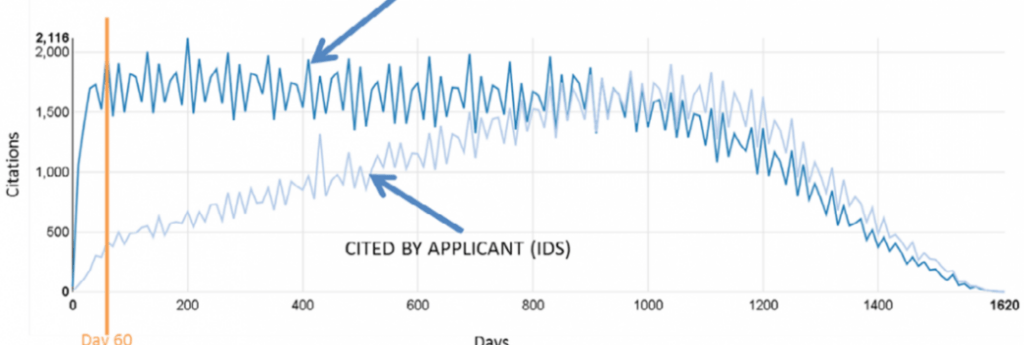by Matt Troyer, Director of Patent Analytics at Anaqua
 Citation analysis has been routinely used for several decades to help assess patent quality and determine how patents impact the competition and affect the world at large. As we saw in Part 1, citations can actually occur more frequently against an application before grant than after. As discussed, examiners cite applications far more often than they cite patents due to temporal co-dependency and multiple discovery. These early citations become difficult to uncover.
Citation analysis has been routinely used for several decades to help assess patent quality and determine how patents impact the competition and affect the world at large. As we saw in Part 1, citations can actually occur more frequently against an application before grant than after. As discussed, examiners cite applications far more often than they cite patents due to temporal co-dependency and multiple discovery. These early citations become difficult to uncover.
Ever notice how innovation and invention occur when they’re ready? From Isaac Newton and Gottfried Leibniz independently inventing calculus in the mid-17th century, to Alan Turing and Emil Post proposing the “Turing Machine” (modern computer) in 1936, the list of co-discovered inventions is practically endless. Among historians and sociologists, this is the concept of “multiple-discovery.”
The same is true for every invention in a patent portfolio. Prior art is more likely to be found in co-pending applications. An artifact of the global patent system that’s co-pending art is invisible until publication of the application. So, you and your competitors don’t know about simultaneous inventions until 18 months after filing of the patent and publication of the application. As a result, examiners base more rejection arguments on co-pending art than non-co-pending patents.
The reasons for this are twofold. First, examiners are more in-tune to co-pending art, and look for prior art where they know they are likely to find it. More importantly, examiners have a time lag advantage; they get to consider 18 months of publications that are invisible to the applicant.
To leverage forward citations fully, having complete and current data provides market details that are otherwise undetectable, such as:
- General activity is a specific technology sector
- Similar competitor product development plans
- If an intriguing technology sector is embryonic, on the rise, mature, or aging
- Filing cited inventions that may not be claimed via the continuation process
This level of insight provides opportunities to act, including:
- Steering development plans to meet a competitor head on, or putting investment resources in less saturated technology spaces
- Identifying potential infringement and licensing opportunities
- Deciding if protected technology has lost value, specifically future value
- Evaluating jurisdictional coverage where present and future products may need protection
- Watching for new entrants into technical spaces
- Establishing that a competitor is aware of your technology
For more from Matt Troyer, read more here.
Matt Troyer is the Director of Patent Analytics at Anaqua, Inc. During his career he has managed the development of several patent search, analysis, reporting and patent evaluation tools. In 2010 he joined the FreePatentsOnline.com team to help create AcclaimIP.com–FPO’s entry into the professional patent search market. Matt supports and trains customers on patent research techniques, consults on patent research and portfolio mining projects, helps clients develop patent landscapes, and uses AcclaimIP to help clients identify patents that are infringed or otherwise licensable. In both 2015 and 2016, Matt was nominated to the IAM Strategy 300–The World’s Leading IP Strategists.

